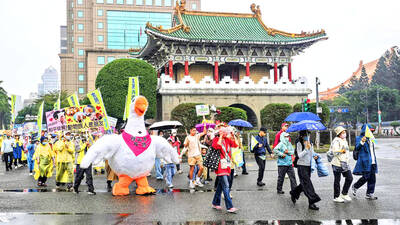The Jiji Line (集集線), one of the nation’s heritage railway routes, will be closed in March because seven of its tunnels between Zhuoshui (濁水) Station and Checheng (車埕) are in need of immediate repairs, the Taiwan Railway Administration (TRA) said last week.
Construction of the line began in 1919 and was completed in 1921. It was purchased by the Japanese colonial government in 1927. The line was severely damaged in the 921 Earthquake in 1999 and did not resume operations until 2002.
The TRA said the seven tunnels to be repaired were built between 1925 and 1960 and their interior walls cracked after the 921 quake.
TRA maintenance work to shore up the tunnels reduced the space inside to the point that only small diesel-powered trains can pass through.
The renovation work will begin on March 1 and end on Jan. 14, next year. During that period, trains will only operate between Ershui (二水) and Longquan (龍泉) stations.
The TRA has arranged with two bus operators to transport passengers from Longquan to Chencheng and will pay them about NT$8.96 million (US$280,000) to cover the ticket costs.
The TRA will also start taking reservations today for special cruise train services to the East Coast this weekend, which are part of celebration of the 30th anniversary of its North Link. The trip will include a brief steam train ride from Hualien to Chungde (崇德), with a CK-124 model locomotive pulling the train.

NUMBERS IMBALANCE: More than 4 million Taiwanese have visited China this year, while only about half a million Chinese have visited here Beijing has yet to respond to Taiwan’s requests for negotiation over matters related to the recovery of cross-strait tourism, the Tourism Administration said yesterday. Taiwan’s tourism authority issued the statement after Chinese-language daily the China Times reported yesterday that the government’s policy of banning group tours to China does not stop Taiwanese from visiting the country. As of October, more than 4.2 million had traveled to China this year, exceeding last year. Beijing estimated the number of Taiwanese tourists in China could reach 4.5 million this year. By contrast, only 500,000 Chinese tourists are expected in Taiwan, the report said. The report

Temperatures are forecast to drop steadily as a continental cold air mass moves across Taiwan, with some areas also likely to see heavy rainfall, the Central Weather Administration (CWA) said. From today through early tomorrow, a cold air mass would keep temperatures low across central and northern Taiwan, and the eastern half of Taiwan proper, with isolated brief showers forecast along Keelung’s north coast, Taipei and New Taipei City’s mountainous areas and eastern Taiwan, it said. Lows of 11°C to 15°C are forecast in central and northern Taiwan, Yilan County, and the outlying Kinmen and Lienchiang (Matsu) counties, and 14°C to 17°C

STEERING FAILURE: The first boat of its class is experiencing teething issues as it readies for acceptance by the navy, according to a recent story about rudder failure The Hai Kun (海鯤), the nation’s first locally built submarine, allegedly suffered a total failure of stern hydraulic systems during the second round of sea acceptance trials on June 26, and sailors were forced to manually operate the X-rudder to turn the submarine and return to port, news Web site Mirror Daily reported yesterday. The report said that tugboats following the Hai Kun assisted the submarine in avoiding collisions with other ships due to the X-rudder malfunctioning. At the time of the report, the submarine had completed its trials and was scheduled to begin diving and surfacing tests in shallow areas. The X-rudder,

DEMAND: The government should enact regulations in line with Austria and Germany to incorporate vegan nutrition into school meals, an advocate said More than 1,000 people yesterday marched in Taipei to promote veganism, calling for legislation to incorporate vegan diets into school lunches and the national net zero emissions program. Participants gathered on Ketagalan Boulevard in front of the Presidential Office Building for the march, which was organized by the Vegan Action Network (VAN). Former ambassador to Chad Chiu Chung-jen (邱仲仁), actor Yankee Yang (楊子儀) and actress Cindy Lien (連俞涵) attended the event. VAN member Marianne Chao (趙梅君) said that the campaign aimed to urge the government to promote vegan diets across schools and government agencies via legislation and national policies, which would help build